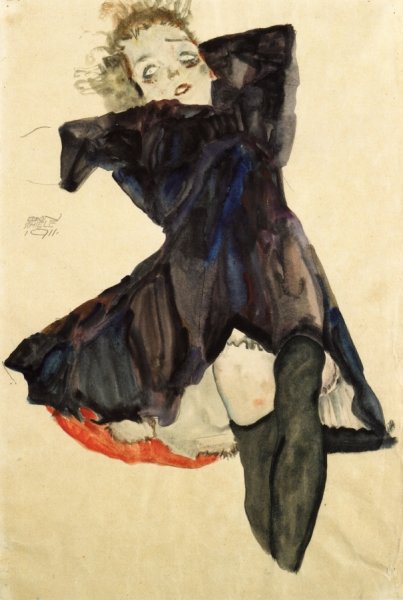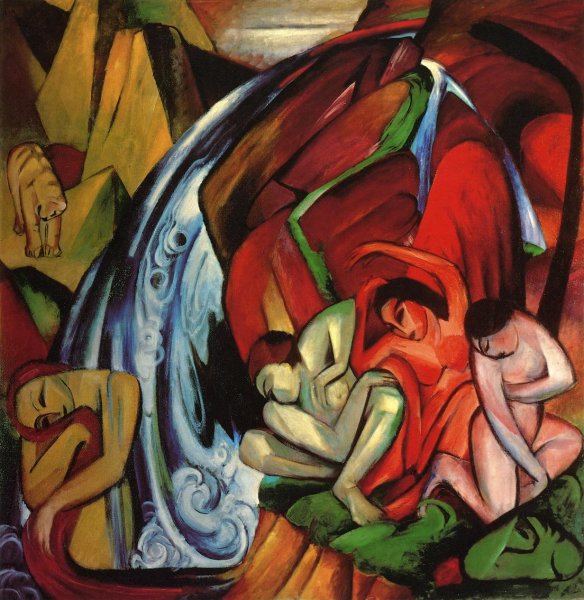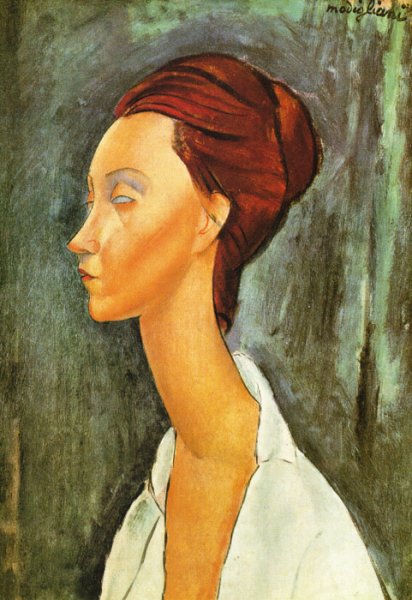Origin of the term

Although it is used as a term of reference, there has never been a distinct movement that called itself "expressionism", apart from the use of the term by Herwarth Walden in his polemic magazine Der Sturm in 1912. The term is usually linked to paintings and graphic work in Germany at the turn of the century which challenged the academic traditions, particularly through the Die Brucke and Der Blaue Reiter groups. Philosopher Friedrich Nietzsche played a key role in originating modern expressionism by clarifying and serving as a conduit for previously neglected currents in ancient art.
In The Birth of Tragedy Nietzsche presented his theory of the ancient dualism between two types of aesthetic experience, namely the Apollonian and the Dionysian; a dualism between the plastic "art of sculpture", of lyrical dream-inspiration, identity (the principium individuationis), order, regularity, and calm repose, and, on the other hand, the non-plastic "art of music", of intoxication, forgetfulness, chaos, and the ecstatic dissolution of identity in the collective. The analogy with the world of the Greek gods typifies the relationship between these extremes: two godsons, incompatible and yet inseparable. According to Nietzsche, both elements are present in any work of art. The basic characteristics of expressionism are Dionysian: bold colours, distorted forms-in-dissolution, two-dimensional, without perspective.
More generally the term refers to art that expresses intense emotion. It is arguable that all artists are expressive but there is a long line of art production in which heavy emphasis is placed on communication through emotion. Such art often occurs during time of social upheaval, and through the tradition of graphic art there is a powerful and moving record of chaos in Europe from the 15th century on the Protestant Reformation, Peasants' War, Eight Years' War, Spanish Occupation of the Netherlands, the rape, pillage and disaster associated with countless periods of chaos and oppression are presented in the documents of the printmaker. Often the work is unimpressive aesthetically, but almost without exception has the capacity to move the viewer to strong emotions with the drama and often horror of the scenes depicted.
The term was also coined by Czech art historian Antonin Matejcek in 1910 as the opposite of impressionism: "An Expressionist wishes, above all, to express himself....(An Expressionist rejects) immediate perception and builds on more complex psychic structures.... Impressions and mental images that pass through mental peoples soul as through a filter which rids them of all substantial accretions to produce their clear essence [...and] are assimilated and condense into more general forms, into types, which he transcribes through simple short-hand formulae and symbols." (Gordon, 1987)
Expressionist groups in painting

The movement primarily originated in Germany and Austria. There were a number of Expressionist groups in painting, including the Blaue Reiter and Die Brucke. The Der Blaue Reiter group was based in Munich and Die Brucke was based originally in Dresden (although some later moved to Berlin). Die Brucke was active for a longer period than Der Blaue Reiter which was only truly together for a year (1912). The Expressionists had many influences, among them Munch, Vincent van Gogh, and African art. They also came to know the work being done by the Fauves in Paris.
Influenced by the Fauves, Expressionism worked with arbitrary colors as well as jarring compositions. In reaction and opposition to French Impressionism which focused on rendering the sheer visual appearance of objects, Expressionist artists sought to capture emotions and subjective interpretations: It was not important to reproduce an aesthetically pleasing impression of the artistic subject matter; the Expressonists focused on capturing vivid emotional reactions through powerful colors and dynamic compositions instead. The leader of Der Blaue Reiter, Kandinsky, would take this a step further. He believed that with simple colors and shapes the spectator could perceive the moods and feelings in the paintings, therefore he made the move to abstraction.
Expressionist imagery exploded into modern art from the subconscious. Its divers formal means and emotional effects range from anguish to exuberance. As the powerful, personal creations of modern individuals, these images have little in common except their inventive power and their reliance upon a distinctly private vision.
In late 1939, at the beginning of World War II, New York welcomed a great number of leading European artists.
The heritage of their interest in the mythic realm of the unconscious would be continued-and extended-by another group of younger, New World artists-New York School.
Following World War II Expressionism began to influence young American artists. Norris Embry (1921-1981) studied with Oskar Kokoschka in 1947 and over the next 43 years produced a large body of work grounded in the Expressionist tradition. Norris Embry has been called "the first American German Expressionist". Other American artists of the late 20th and early 21st century have developed distinct movements that are generally considered part of Expressionism. Another prominent artist who came from the German Expressionist "school" was Bremen born Wolfgang Degenhardt. After working as a commercial artist in Bremen he migrated to Australia in 1954 and became quite prominent and sought after in the Hunter Valley region. His paintings captured the spirit of Australian and world issues but presented them in a way which was true to his German Expressionist roots.
American Expressionism and American Figurative Expressionism particularly the Boston figurative expressionism were an integral part of American modernism around the Second World War.
Major figurative Boston expressionists included: Karl Zerbe, Hyman Bloom, Jack Levine, David Aronson, Philip Guston. The Boston figurative expressionists post World War II were increasingly marginalized by the development of abstract expressionism centered in New York City.
Later in the 20th century, after World War II, figurative expressionism influenced worldwide a large number of artists and movements. Thomas B. Hess, wrote:
"the 'New figurative painting' which some have been expecting as a reaction against Abstract Expressionism was implicit in it at the start, and is one of its most lineal continuities."
New York Figurative Expressionism

- New York Figurative Expressionism of the fifties represented New York figurative artists such as: Robert Beauchamp, Elaine de Kooning, Robert Goodnough, Grace Hartigan, Lester Johnson, Alex Katz, George McNeil, Jan Muller, Fairfield Porter, Larry Rivers and Bob Thompson.
- Lyrical Abstraction, Tachisme of the 1940s and 1950s in Europe represented by artists such as Georges Mathieu, Hans Hartung, Nicolas de Stael and others.
- Bay Area Figurative Movement represented by the early figurative expressionists from the San Francisco area Elmer Bischoff Richard Diebenkorn, and David Park. The movement from 1950-1965 was joined by Theophilius Brown, Paul Wonner, James Weeks, Hassel Smith, Nathan Oliveira, Bruce McGaw, Joan Brown, Manual Neri, Joan Savo and Roland Peterson.
- Abstract Expressionism, of the 1950s represented American artists such as Louise Bourgeois, Hans Burkhardt, Mary Callery, Nicolas Carone, Willem de Kooning, Jackson Pollock, and others that took part in figurative expressionism.
- In the United States and Canada Lyrical Abstraction beginning in the late 1960s and the 1970s. Characterized by the work of Dan Christensen, Peter Young, Ronnie Landfield, Ronald Davis, Larry Poons, Walter Darby Bannard, Charles Arnoldi, Pat Lipsky and many others.
Neo-expressionism was an international revival movement beginning in the late 1970s and centered around artists across the world:
- Germany: Anselm Kiefer and Georg Baselitz and others;
- USA: Jean-Michel Basquiat, Eric Fischl, David Salle and Julian Schnabel;
- Cuba: Pablo Carreno;
- France: Remi Blanchard, Herve Di Rosa and others;
- Italy: Francesco Clemente, Sandro Chia and Enzo Cucchi;
- England: David Hockney, Frank Auerbach and Leon Kossoff (From Wikipedia)




